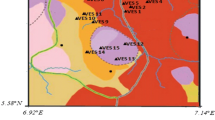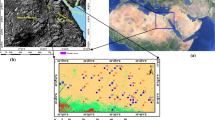Abstract
A geoelectrical resistivity survey using vertical electrical sounding (VES) was conducted at Chaj Doab (land between rivers Jhelum and Chenab, Pakistan) and Rachna Doab (land between rivers Chenab and Ravi, Pakistan), with the objective of investigating groundwater conditions. A total of 90 sites were selected with 43 sites in Chaj and 47 sites in Rachna Doabs. The resistivity meter (ABEM Terrameter SAS 4000, Sweden) was used to collect the VES data by employing a Schlumberger electrode configuration, with half current electrode spacings (AB/2) ranging from 2 to 180 m and the potential electrode (MN) from 1 to 40 m. The field data were interpreted using the Interpex IX1D computer software and the resistivity versus depth models for each location was estimated. The outputs of subsurface layers with resistivities and thickness presented in contour maps and 3-D views by using SURFER software were created. A total of 102 groundwater samples from nearby hydrowells at different depths were collected to develop a correlation between the aquifer resistivity of VES and the electrical conductivity (EC) of the groundwater and to confirm the resulted geophysical resistivity models. From the correlation developed, it was observed that the groundwater salinity in the aquifer may be considered low and so safe for irrigation if resistivity >45 Ω m, and marginally fit for irrigation having resistivity between 25 and 45 Ω m. The study area has resistivities from 3.9 to 2,222 Ω m at the top of the unsaturated layer, between 1.21 and 171 Ω m, in the shallow aquifers, and 0.14–152 Ω m in the deep aquifers of the study area. The results indicate that the quality of groundwater is better near the rivers and in the shallow layers compared to the deep layers.












Similar content being viewed by others
References
Ahmed N, Chaudhry GR (1987) Irrigated agriculture of Pakistan. Lahore, Pakistan
Ashraf A, Ahmad A (2008) Regional groundwater flow modeling of upper Chaj Doab of Indus Basin, Pakistan, using finite element model (Feflow) and geoinformatics. Geophys J Int 173:17–24
Badruddin M (1983) Concept of command water management project. In: Proceedings of the international seminar on water resources management, Lahore, Pakistan, pp 1–8
Bakhsh A, Awan QA (2002) Water issues in Pakistan and their remedies. In: National symposium on drought and water resources in Pakistan, 16th March 2002, CEWRE, University of Engineering and Technology Lahore, Pakistan, pp 145–150
Bhimasankaram VLS, Gaur VK (1977) Lectures on exploration geophysics for geologists and engineers. Assoc Explor Geophysicists, Centre Explor Geophys, Hyderabad, India
Bhutta MN, Vander Velde EJ (1992) Equity of water distribution along secondary canals in Punjab, Pakistan. Irrig Drain Syst 6:161–177
Bhutta MN, Wolters W (1996) Issue paper: drainage and the environment in Pakistan. In: Proceedings of the national conference on managing irrigation for environmentally sustainable agriculture in Pakistan, 5–7 November, vol 1, IIMI, Lahore
Choudhury K, Saha DK (2004) Integrated geophysical and chemical study of saline water intrusion. Ground Water 42:671–677
Gupta RK, Singh NT, Sethi M (1994) Groundwater quality for irrigation in India. In: Technical bulletin, CSSRI, Karnal, India, 19:1–13
I and P (2005) A report on groundwater monitoring network of the directorate of land reclamation Punjab. Irrigation and Power Department, Lahore, Pakistan
Kalisperi D, Soupios P, Kouli M, Barsukov P, Kershaw S, Collins P, Vallianatos F (2009) Coastal aquifer assessment using geophysical methods (TEM, VES), case study: Northern Crete, Greece, 3rd IASME/WSEAS international conference on geology and seismology (GES ‘09) Cambridge, UK, 24–26 February 2009
Kidwai ZD (1962) The geology of Rachna and Chaj Doabs, Water and Power Development Authority, Water and Soils Investigation Division, Bulletin no. 5
Koefoed GD (1979) Geosounding principles, resistivity sounding measurements. Elsevier, New York
Kuper M, Kijne JW (1992) Irrigation management in the Fordwah branch command area, South-East Punjab, Pakistan. Paper presented at the internal program review, International Irrigation Management Institute, Colombo, Sri Lanka
Lashkaripour GR (2003) An investigation of groundwater condition by geoelectrical resistivity method: a case study in Korin aquifer, southeast Iran. J Spat Hydrol 3:1–5
Lashkaripour GR, Ghafoori M, Dehghani A (2005) Electrical resistivity survey for predicting Samsor aquifer properties, Southeast Iran. Geophysical Research Abstracts, European Geosciences Union 7:1–5
Malik DM (1990) Welcome address. In: Proceedings of the second national congress on soil science, Faisalabad, Pakistan, pp 1–15
MINFAL (2007) Agricultural Statistics of Pakistan, Govt. of Pakistan, Ministry of Food, Agriculture and Livestock, (Economic Wing), Islamabad
Mondal NC, Singh VS (2007) Integrated approach to delineate the contaminated groundwater in the tannery belt: a case study from Groundwater Group, National Geophysical Research Institute Hyderabad, India
Oseji JO, Asokhia MB, Okolie EC (2006) Determination of groundwater potential in Obiaruku and environs using surface geoelectric sounding. Environmentalist 26:301–308
Palacky GJ (1987) Clay mapping using electromagnetic methods. First Break 5:295–306
Sahu PC, Sahoo H (2006) Targeting groundwater in tribal dominated Bonai area of drought-prone Sundargarh District, Orissa, India. A combined geophysical and remote sensing approach. J Hum Ecol 20:109–115
Sarwar A, Eggers H (2006) Development of a conjunctive use model to evaluate alternative management options for surface and groundwater resources. Hydrogeol J 14:1676–1687. doi:10.1007/s10040-006-0066-8
Shankar KR (1994) Affordable water supply and sanitation. In: Groundwater exploration 20th WEDC Conference Colombo, Sri Lanka, 1994, pp 225–228
Sikandar P, Bakhsh A, Rana T (2008) Geoelectrical resistivity method for assessing fresh groundwater layer at farmer’s fields. Paper submitted to the J Environ Geol
Singh KP (2005) Nonlinear estimation of aquifer parameters from surficial resistivity measurements. Hydrol Earth Sys Sci Discuss 2:917–938
Soupios P, Kouli M, Vallianatos F, Vafidis A, Stavroulakis G (2007) Estimation of aquifer parameters from surficial geophysical methods. A case study of Keritis Basin in Crete. J Hydrol 338:122–131
Stampolidis A, Tsourlos P, Soupios P, Mimides TH, Tsokas G, Vargemezis G, Vafidis A (2005) Integrated geophysical investigation around the brackish spring of Rina, Kalimnos Isl., SW Greece. J Balk Geophys Soc 8(3):63–73
Vouillamoz JM, Baltassat JM, Girard JF, Plata J, Legchenko A (2007) Hydrogeological experience in the use of MRS. Bol Geol Min 118(3):531–550
Wannakomol (2005) Soil and groundwater salinization problems in the Khorat Plateau, NE Thailand, integrated study of remote sensing, geophysical and field data. Fachbereich Geowissenschaften, Freie University, Berlin. http://www.diss.fu-erlin.de/2005/210/indexe
WAPDA (1978) Report on Soil Salinity Survey and Research Division. Vol 1, Water and Power Development Authority (WAPDA), Lahore. (Supplement to Revised Action Program for Irrigated Agriculture, Annexes for water quality
Ward SH (1990) Resistivity and induced polarization methods. Geotechnical and Environmental Geophysics, vol 1. Society of Exploration Geophysics
WASID (1964) Analysis of aquifer tests in the Punjab region of west Pakistan, water and soils investigation division. Water and Power Development Authority, Lahore
World Bank (2005) Pakistan Country Water Resources Assistance Strategy Water Economy Report No. 34081-PK, the World Bank South Asia Region, Islamabad, Pakistan
Zohdy AAR, Martin RJ (1993) A study of seawater intrusion using direct-current soundings in the southern part of the Oxward Plain, California. Open-File Report, US Geological Survey 139, pp 93–524
Zohdy A, Eaton GP, Mabey DR (1974) Application of surface geophysics to ground-water investigations: techniques of water-resources investigations of the United States Geological Survey, chap D1, book 2, 116 p
Acknowledgments
This research project has been supported as Indigenous Ph.D. 5000 scholarship scheme funding from the Higher Education Commission, Islamabad, Pakistan, for which we express our sincere thanks. Appreciations are also extended to the Agriculture Department, Agricultural Engineering Field Wing, Punjab, and various farmers for their co-operation and assistance. Authors wish to thank CSIRO Land and Water, Australia, for providing their technical support and advanced softwares.
Author information
Authors and Affiliations
Corresponding author
Rights and permissions
About this article
Cite this article
Sikandar, P., Bakhsh, A., Arshad, M. et al. The use of vertical electrical sounding resistivity method for the location of low salinity groundwater for irrigation in Chaj and Rachna Doabs. Environ Earth Sci 60, 1113–1129 (2010). https://doi.org/10.1007/s12665-009-0255-6
Received:
Accepted:
Published:
Issue Date:
DOI: https://doi.org/10.1007/s12665-009-0255-6




